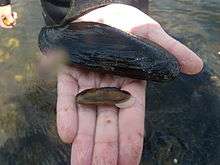Spectacle case pearly mussel
| Spectacle case pearly mussel | |
|---|---|
 | |
| Mature and young Cumberlandia monodonta. | |
| Scientific classification | |
| Kingdom: | Animalia |
| Phylum: | Mollusca |
| Class: | Bivalvia |
| Order: | Unionoida |
| Family: | Margaritiferidae |
| Genus: | Cumberlandia |
| Species: | C. monodonta |
| Binomial name | |
| Cumberlandia monodonta (Say, 1829) | |
| Synonyms | |
|
Margaritifera monodonta Say, 1829 | |
The spectacle case pearly mussel or spectacle case (Cumberlandia monodonta) is a species of bivalve in the family Margaritiferidae. It is endemic to the United States. The spectaclecase is a freshwater mussel that the U.S. Fish and Wildlife Service listed as an endangered species.[2]
Historically, the spectaclecase was found in at least 44 streams of the Mississippi, Ohio and Missouri River basins in 14 states. It has been extirpated from 3 states and today is found in only 20 streams. The spectaclecase’s current range includes Alabama, Arkansas, Illinois, Iowa, Kentucky, Minnesota, Missouri, Tennessee, Virginia, West Virginia, and Wisconsin. With few exceptions, spectaclecase populations are fragmented and restricted to short stream reaches.[2]
Spectaclecase mussels are found in large rivers where they live in areas sheltered from the main force of the river current. This species often clusters in firm mud and in sheltered areas, such as beneath rock slabs, between boulders and even under tree roots.[2]
Description
The shell of the spectaclecase is elongate and compressed, with a concave ventral margin. It can be up to 23 cm (9 in.) long. The outside of the shell is dark brown to black, and rayless. The pseudocardinal teeth are poorly developed, lateral teeth are absent, and the inside of the shell is white. The spectaclecase resembles the black sandshell (Liguma recta), but the black sandshell has well-developed pseudocardinal and lateral teeth, and the outside of the shell is often rayed.[3] The life cycle of the spectaclecase is complex and includes a stage parasitic on fish or other host species. Males release sperm into the river current. As females siphon water for food and respiration, they also siphon sperm that fertilizes their eggs. Within special gill chambers, fertilized eggs develop into microscopic larvae called glochidia. After they mature, female mussels expel the glochidia, which must then attach to the gills or fins of a specific species, usually a fish, to continue developing into a juvenile mussel. If glochidia successfully attach to a host, they mature into juvenile mussels, and then drop off. If they land in a suitable area, glochidia grow into adult mussels. Using fish (or other aquatic species) as a host allows the spectaclecase to move upstream and populate habitats it could not otherwise reach. The host species for spectaclecase are not known.[2] A critical research need includes the identification of the primary larval fish host for this mussel species, which could aid in its conservation.[3]
Threats
Dams
Population losses due to dams have contributed more to the decline and potential extinction of the spectaclecase than any other factor. Dams affect both upstream and downstream populations by disrupting seasonal flow patterns, scouring river bottoms, changing water temperatures and eliminating river habitat. Large rivers throughout nearly all of the spectaclecase mussel’s range have been dammed, leaving short, isolated patches of habitat between dams. Spectaclecase mussels likely depend on a fish species, or other aquatic species, to move upstream.[2]
Because dams block fish passage, mussels are also prevented from moving upstream. This isolates upstream populations from those downstream, leading to small, unstable populations, which are more likely to die out.[2]
Small population size and fragmentation
Most remaining populations of spectaclecase are small and geographically isolated. Small populations remaining in short sections of rivers are susceptible to extirpation from single catastrophic events, such as a toxic spill. Also, this level of isolation makes natural repopulation of areas that once supported mussels impossible without human intervention.[2]
Sedimentation
Poor land use practices, dredging, intensive timber harvests, highway construction, and other activities accelerate erosion and increase sedimentation. Sediment that blankets a river bottom can suffocate mussels since they cannot move to avoid the impact. Also, large amounts of sediment in the water column reduce the ability of mussels to remove food and oxygen, which can lead to reduced growth, reproduction and survival.[2]
Pollution
Adult mussels are easily harmed by toxins and degraded water quality from pollution because they are sedentary (they tend to stay in one place). Pollution may come from specific, identifiable locations such as accidental spills, factory discharges, sewage treatment plants and landfills, or from diffuse sources like runoff from fields, feedlots, mines, construction sites and roads.[2]
Contaminants may directly kill mussels, but they may also indirectly harm spectaclecase by reducing water quality, affecting the ability of surviving mussels to reproduce and lowering the numbers of host fish.[2]
Channelization
Dredging and channelization have profoundly altered riverine habitats nationwide. Channelization physically changes streams by accelerating erosion, reducing depths, decreasing habitat diversity, destabilizing stream bottoms and removing riparian vegetation.[2]
Nonnative species
The invasion of the nonnative zebra mussel into the United States poses a serious threat to native mussels. Zebra mussels proliferate in such high numbers that they use up food resources. They attach to native mussel shells in such large numbers that the native mussel cannot open its shell to eat or breathe.[2]
References
- ↑ Cummings, K. & Cordeiro, J. (2012). "Cumberlandia monodonta". The IUCN Red List of Threatened Species. IUCN. 2012: e.T5952A3078239. doi:10.2305/IUCN.UK.2012.RLTS.T5952A3078239.en. Retrieved 8 November 2017.
- 1 2 3 4 5 6 7 8 9 10 11 12 "Specataclecase (Cumberlandia monodonta) Fact Sheet". United States Fish & Wildlife Service. Retrieved 20 January 2017.

- 1 2 Sietman, B. E. 2003. Field guide to the freshwater mussels of Minnesota. Minnesota Department of Natural Resources, St. Paul, Minnesota. 144 pp.
Additional sources
- Mollusc Specialist Group 2000.
- Cumberlandia monodonta
- 2006 IUCN Red List of Threatened Species. Downloaded on 6 August 2007.
- http://www.dnr.state.mn.us/rsg/profile.html?action=elementDetail&selectedElement=IMBIV08010#
